
|
||
|
Portland art blog + news + exhibition reviews + galleries + contemporary northwest art
|
||
Interview with Nina Katchadourian 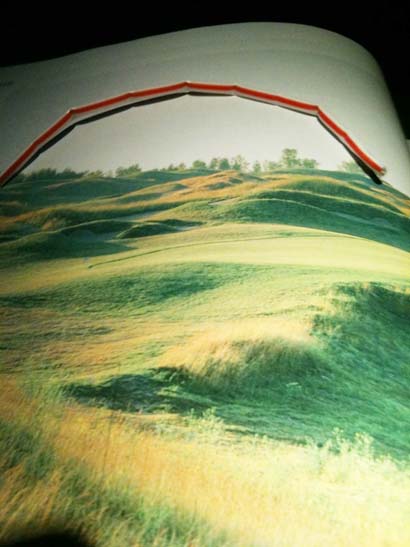
Straw Utopia (LGA --> ATL), From the Seat Assignment series, (Courtesy of the artist) GW: You spent a lot of time in Northern Europe it seems? NK: I have a mother who comes from Finland. So I have spent part of every summer of my life growing up there. It's a place that my family convenes in every year. It is a little island off the south coast. It's very, very far away mentally at least. from the rest of my life. Very different from Brooklyn where I live. This Island has, over the years, become a really important place for me to go to on occasion to make work. There are a lot of projects that have happened in the spirit of play, like the one you have up right now Artificial Insemination [on computer] about artificial insemination which was me looking at a pond of tadpoles and thinking... GW: Was that created in Finland? 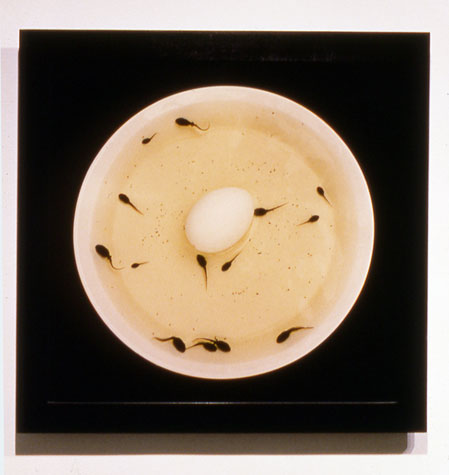
Artificial Insemination, C-print, 20 x 20 inches, 1998 NK: Yeah. That happened one summer. I was actually there on my own for a couple weeks on that island and I saw these tad poles in the pond and I thought it would be amazing if you put a chicken egg in there and they all kind of swarmed it and you would get this picture of the sperm fertilizing the egg in a science textbook. I put the egg in the pond and, of course, the tadpoles couldn't have cared less about it. So I had to fish out a bunch of tadpoles, borrow them for a little bit, went up to the house, took out a dinner plate from the cupboard, and an egg from the fridge and assembled this whole thing on a black T shirt that I was wearing and took the picture. GW: Did you make a video of this? NK: I also made a video of it. They sort of swim around the edges of the plate, they look very scared of it. GW: That would be really fun. NK: Yeah, so there were a lot of things that summer, including this series [indicates toward screen] the Spider Web Series, which, may be has been the work that I have exhibited more than anything else. I was finding broken spiderwebs and repairing them with sewing thread. What would happen was the spider would come in and kick out these patches and fix the web again. So we were sort of in this battle of one upmanship about who knew how to fix the web the best way. GW: They got rid of the thread? 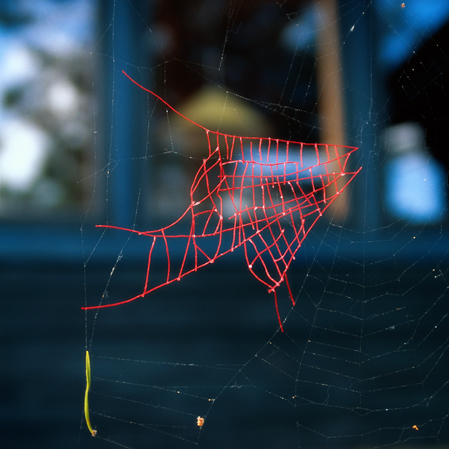
Mended Spiderweb #8 (Fish Patch), Cibachrome, 20 x 20 inches, 1998 NK: Yes GW: So you were creating a temporary band-aid? NK: Well, yeah, the whole question if I am really trying to help them hovers over the work. Its a really meddlesome act to go in there with... GW: It's like Social Practice. NK: Oh! [Laughs a little uncomfortably] GW: I can say that because I have worked in that way. NK: Yeah, yeah. So this project marks the beginning of a lot of work that I have done that relates to our relationship to the natural world. Specifically to animals. GW: So animals are an area of interest? NK: I am interested in what we want from animals. Like what it is that we see in them. Or project onto them. Or hope to get from them. What they seem to tell us about ourselves. All the metaphorical overlay that we throw on them. GW: Personification? NK: Yes, anthropomorphizing them. I made a piece two years ago that I don't think is up on my site yet. A big project called Zoo which is a 19 channel video installation. I have been shooting footage in zoos for the past...eight years now and then it finally became this kind of room sized piece. with lots of snippets of animal parts or activities, but it is often very hard to know exactly what you are looking at. You might see an animal that you think is kind of huge but it turns out to be a little rodent sized thing. Diorama. I think the thing is that we go to zoos a lot thinking that the animals will behave a certain way for us and a lot of the time they are just sitting there asleep or doing something that is very anticlimactic or disappointing. And there is this urge to kind of communicate, but its a very one way street. We are here. There's a little label that says what the animal is over there and you're supposed to read this thing and get it. In some ways may be, by reading about it and having knowledge over it, may be...I think of it as a power dynamic of sorts. We kind of know it therefore we have it. So animals keep coming up. It's one thread of many, but I think it is probably going to stick around for a long time. GW: It does seem that you have a number of trajectories of investigation. When you talk about investigating animals Fritz Haeg comes to mind. NK: Fritz Haeg who does the garden project? GW: Yeah but he also has another project that was in the Whitney a couple of years ago. NK: Did he do the big birds outside? GW: Yes. NK: I don't know him personally. I have seen his work here and there, but I'm not sure how to describe how he thinks of the human/animal relationship. What's your understanding of it? GW: He comes from a more conservation point of view. Animal Estates is the name of that project. It is very site specific in that he researches marginalized or endangered animals of a specific place and then creates mini habitats in the urban landscape that they could inhabit. NK: Right. I think I am actually not coming at this topic in exactly the same way especially with the spider work. I am trying to look at the way that we have a rather competitive and fraught and often damaging relationship to nature or animals. For example, you might think, 'How nice that she is mending spider webs', but really there is a lot of evidence in the pictures and the video that I made that goes along with the pictures that I am doing way more harm than good by messing around in there and I was sort of, never invited in the first place. GW: Exactly. Right? NK: The spiders were happy to see me go. GW: They were pretty pissed off? NK: They were kind of pissed off. GW: I feel like spiders are pissed off most of the time. NK: [laughing] I feel like I owe them my career actually so I am very kind to them. It is also funny, it's been pointed out to me, I have done a lot of work with animals in the very "uncute" category of animals, so spiders, snakes, rats, sharks. GW: Animals that are very necessary to our survival but we also fear them...generally. NK: Yeah, where its hard to do that thing where it's like, Oh the baby polar bear, I wanna be just like it, you know? It's harder to feel that way about a spider or a snake. They are really foreign, more foreign in some ways as animal bodies than other things are. There's a project called The Continuum of Cute that we can also look at that is on this topic...[Sound of navigating the internet] It is the only web based project I have ever done; i was invited to make something for the New Museum. When you go to the site you end up with a grid of 100 animals that are all found online and you are asked to arrange these animals in order of cuteness. I have been thinking about this question of what's cute. Because we kind of know it when we see it and we have strong feelings about it often. What's been fun is finding animals that are really hard to decide about for example... GW: Like this thing? [pointing to screen] NK: Yes, this thing is what is called a Dumbo Octopus. If you click on it there you should be able to see it... GW: Oh, god. 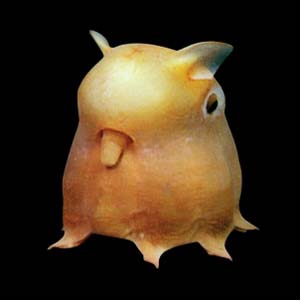
Dumbo Octopus NK: Isn't that great? It looks like a Pokeomon. But to me, this baby polar bear is absolutely irresistible. I can't stand how cute that is. And then there are...I mean it is ridiculous. On the other hand like this is a good example, this is called a Blob Fish. It's sort of in this category of ugly-cute, sort of pathetic but sort of sweet looking to me, but for some people this ends up on the way uncute end and for others it ends up on the cuter end. GW: I think it is the visceral sliminess... 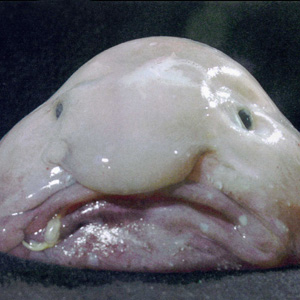
Blob Fish NK: Oh, god, and this goo coming out of its mouth. Really vile. And then there are animals, let me find you an example of...what do you do about a...like a lion? Beautiful animal, but is it cute? It's not exactly cute. So some of these end up in this interesting middle zone. And then if you click on this link here, it allows you to see what other people have determined as cute. Unfortunately this is not functioning right at the moment but... GW: There's quite a few on here though...Oh man, look at that. That is a hairless cat. NK: That is a hairless cat, yes. GW: So it goes from not cute to cute? Left to right? NK: Yeah, so if you scroll down and pull this bar across you'll see that as things get cuter and cuter they get fuzzier and younger... GW: Man, people think slugs are cute? NK: See, I have an aversion to slugs. Those would be way on the uncute end to me but some people... GW: Have you encountered the Banana Slug? NK: I grew up in California, where there were [sound of disgust] they are horrifying to me. Go all the way to the right and you will see how many polar bears and fuzzy, you know like... GW: Oh look, someone thought the octopus was cute. NK: Yes. And if you double click on...if you double click anything really, it will show you where that animal pops up on the whole spectrum so... GW: You worked with a web developer to create this? NK: I art directed the page and these people built it for me. Its the only web thing I have ever made...the interactive format suited itself really well to this idea. Yeah, I think about words like cute and I think about words like natural which we always have a fondness for but are pretty complicated words and I think we have a set of double standards around. So you will notice on my site that there are lots of...well lets see, there is a project called Natural Car Alarms for example, I redesigned the standard six tone car alarm that is really ubiquitous in New York City and replaced all of these six tones with bird calls instead, but birds that sounded a lot like alarms so it is a very abrasive, loud, harsh sound situation. It's not a sound beautification project, but it does get very confusing. GW: Did you just install that in one car? NK: No, three cars and took them around like a little flock to a few different locations... While listening back to the interview recording I discovered that my recording device had malfunctioned and I had not recorded the last third of the interview. Katchedourian was kind enough to speak to me again to recapture some of the lost information. I caught up with her via cell phone as she waited to board a flight from Portland to San Francisco. GW: Hello! Thanks so much for talking to me in lieu of the failure of my technology. I appreciate it very much. NK: Sure. GW: You were not feeling very well at the opening [at the Feldman Gallery] last night when I spoke to you. Are you feeling better? NK: Yeah, I wasn't feeling very well all afternoon but by the end of the night I had rallied back. Yeah it was a great night. The cab driver that drove me to the airport turned out to be a former photo art gallery dealer. It was such a weird thing...he was like, 'What have you been doing in Portland?' I have been having a show, 'Oh, I used to be an art dealer', And now he is driving a cab. GW: Where was his gallery? NK: I don't know I didn't actually ask him what his gallery was called. He was a very nice guy, his name was Guy...something. A photo dealer...anyway. GW: So, had you been in Portland before? NK: Only in December for this very brief site visit to meet with Mack and do a talk at the Museum of Contemporary Craft. GW: How do you feel about your experiences in Portland? NK: How do I feel about it? I had a great time on this visit. I actually had some time on this visit to take a look around a little bit. It's interesting I am from California but it feels sort of...in a West Coast culture sort of way familiar to me, but its not California. It's a part of the country I really don't know which is strange given how much I have traveled. From San Francisco South I am very familiar but North of that I am not familiar. I have never been to Seattle either. GW: Hopefully we will be seeing more of you. You mentioned that you have been traveling a lot? NK: Yeah, I'm lucky, I get to travel a lot these days. It's rare that two weeks go by that I am not getting on a plane to go somewhere at the moment. Well, may be not that frequently, but it is sort of the way that I can handle living in New York because I get really stir crazy there if I don't get out. So coming and going even on short trips keeps it from feeling claustrophobic there. GW: It can be a bit intense. NK: Yeah, it's just my own thing to be one part really into cities and the other wanting to be in the most remote places possible. I have this kind of schizophrenic personality that way. GW: Sounds like you grew up doing that. NK: Yeah, we were talking about Finland and all that stuff. It has become really important to get away, really far away, a couple times a year from anything city-like. In part that is why I am so excited about New Zealand. Things are going to be fantastically remote [laughs]. So do you want to recap? I am not sure what you want to...recover from yesterday? What didn't get recorded? 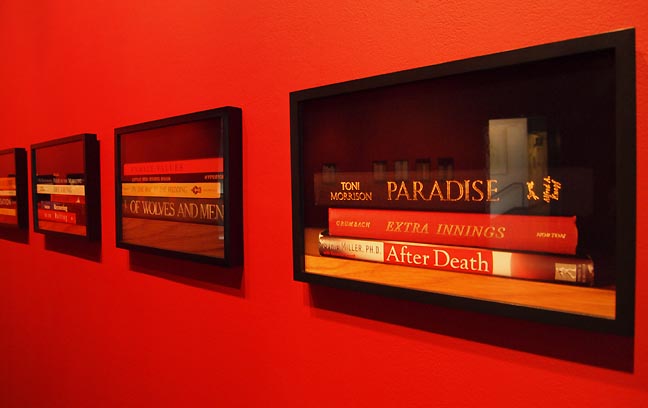 Sorted Books at PNCA's Feldman Gallery GW: Yeah, if you don't mind talking about Sorted Books, may be a brief history and working with Lisa Radon, Tim DuRoche, and family. NK: Sorted Books started in grad school when a bunch of us decided to, we were invited by a friends parents to live and work in the house for about a week and make art with what we found. I got really interested in the couple's books and ended up spending days and days in their bookshelves pouring over their books and then eventually doing this thing, putting them into stacks. I never intended to do anything more with this than show them a sited situation of books on shelves but then photographed them to document them and then over the years this has really become more of a photography project as well as, in the case of this show, where the actual books are shown. So, a few years ago the project started getting blogged. A lot. I wish I could figure out where that all began. I think that site Boing Boing ran something about it and a lot of people read that and from there it kind of just spread. There was suddenly a lot of things online where people were trying their own hand at this. Somebody set up a Flickr page saying, Here's my version of Nina Katchedourian's Sorted Books, and I really liked that. It sort of gave me the idea of what would happen if I intentionally put this project into other people's hands. So I have worked with a couple art classes and students from different schools. This show I thought it would be interesting to work with a family so Mack helped me find Tim and Lisa and all of them, their three kids, combined their books from their entire collections. To make the pieces that are in the show. GW: So they were involved in the arrangement or sorting of the books? NK: They did it all. I didn't do anything. GW: You acted more as facilitator. NK: Yeah, I spoke to them on the phone I sort of explained how the project worked, they looked all over my web site. Those pictures and then they set about doing it. And when i got here they had all the books and...one second [sound of boarding call] Oh, Sacramento, so I mean everything was great but I made a couple little tweaks and I talked about a few suggestions about how to make them read more clearly, take a book out here or there, switch the sequence. You know I did very minor edits. I basically came in their final form. So that is their work, harnessing my idea, making their version of it. GW: I did notice that the voice in that area [of the exhibition] was a lot different than the photographs. NK: It is different and it is interesting to me. And until trying it this way I have never really known how individual each voice might be, but it turns out it is that way and it turns out I have certain hallmark things that I like to do, certain words, phrases that I know work really well for this project that I go searching for. I have a few tricks up my sleeve. It was a really nice opportunity to also get to know some people here. I like the idea of bringing something in that is distinct to the place. GW: You mentioned you have been doing a lot of work on planes? NK: Because I travel so much and I want to make use of those hours in some way - plane travel to me is usually the kind of experience where you are at point A and you want to go to point B and you pretty much forget about everything that happens between point A and B. Do you know what the Sky Mall Catalog is? A few months ago I ended up looking through that, I'm sort of obsessed with it. Every single time I am on a flight I have to look through every page of it. It is a ritual at this point. And I lead this other life as a singer musician and I ended up writing this song on the plane about the cats that appear on Sky Mall and made this ridiculous little video when I got home by scanning a bunch of pictures out of the Sky Mall Catalog and linking them up to this song called Sky Mall Kitties. It had this minor viral moment on Youtube and it peaked out at - something like 60,000 views - which really isn't that many, but Sky Mall Kitties, though I didn't really make it as an artwork, really raised the question for me, what happens when you try to make something, using what you've got in these kinds of circumstances - in flight travel. It has led to, now, this project called Seat Assignment where I am trying to use whatever I have at hand and using only my phone to document, mostly only photographic situations where I am laying pretzels, crumbled up pretzels from the snack they hand you, on the page of a landscape or something. Little movies have also come into play. I think there is a lot more to do that doesn't involve 2D situations but actually talking to the person next to me - interviewing them for example - asking them about their reading - whatever it is I think there is the potential to engage my fellow passengers in a way that I haven't had the guts to do yet. But I will. Soon the Seat Assignment project will be published in this little LA art magazine called Extra. I'm also working on the massive "Jumbo" marathon flying to New Zealand from New York where I have 27 hours or so to...basically make the show that I am going to have in Dunedin. A colossal endurance test of my stamina and creativity. I am sure that I will hit a wall at some point and just completely not be able to do it, but that's part of it too. GW: Yeah, I've certainly made that trip. NK: [laughing] Yeah, I know, I know! I'm scared to ask you how truly exhausting it is. I flew to Sydney from San Francisco before but, boy, that seems kind of easy compared to New York Dunedin. So, you know, the Seat Assignment project is very much in keeping with a lot of ways I work and in keeping with a lot of things I believe in which is there is a lot to the everyday, more than meets the eye, there's a lot you can do with very little, there's a lot you can do by just recontextualizing what's in front of you. The Sorted Books project works that way. There are already books on the shelves. I am just creating a new order for them - pulling out a different kind of meaning. In some ways the plane project is very similar. It is just how you combine your ingredients that leads to something meaningful, and, as with a lot of things that I make, sometimes I start out not knowing exactly what it's going to be, but when you have enough stuff made you sort of have a critical mass situation where you can step back and take a look at it and kind of act as your own curator, say, what is this really about? See where the themes lie and where the connecting threads are. There are a lot of landscapes [in Seat Assignment] - thinking about stuff on a plane - you are in a weird, particular kind of landscape but you are also moving over landscapes and between landscapes and there is something that just makes sense about making landscapes on a plane. GW: It is certainly a curious way of moving through the landscape, the airplane, that's for sure. NK: And from up there you also have impossible views on the landscape that you never get, you know, that's another thing, so far I don't think I have ever had a window seat while I have done this, so I have been a little limited - I haven't really dealt with the view outside much I have really been dealing with the view inside the plane so far. May be on this flight I'll have a window seat. GW: That's interesting because you have done tons of work with maps as well. It seems to be an area of interest... 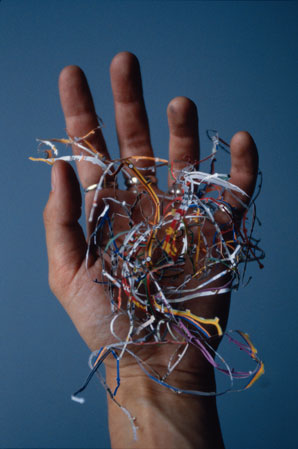
Hand-held Subway, Cibachrome, 13 x 19 inches, 1996 NK: Yeah, the first work I ever made had to do with maps, that's kind of where all this stuff began really. All this art stuff. I'm very fond of maps. Yeah and there is, I think I showed you the ice on the maps of the flight magazine? GW: Yes. NK: I have done a few things with maps in the plane context but it is sort of different than looking out the window. GW: I told you about the New Zealand glow worms yesterday, and you have done a lot of work with insects in the past, do you think there might be a possibility that you will include them in your work? NK: [Laughs] Include glow worms in my project! It's possible, I'll see when I get up there. Well, yeah, worms - I don't know do caterpillars count? GW: Tadpoles. NK: Tadpoles. So, worms might make there way in. I am actually terrified of worms - it's kind of funny - I don't mind spiders, snakes, rats, I don't mind any of those things you're supposed to be afraid of but, earthworms, Oh, god! I have to leave the room - or leeches, even worse, you've hit some phobic spot with those. GW: The glow worms actually make webs. That's why I mentioned it. NK: You know, have you seen the Planet Earth series? You know that BBC nature documentary series? GW: Yes. NK: Is it like those? There's a section on caves and there are these amazing worms that live in the ceilings of these caves and spin these crazy networks. That's what I'm imagining... GW: Yes, it is like that. NK: Wow. Oh yeah, wow I'd really love to see that. GW: So, do you have much time left? NK: Yeah, I'm watching the thing. Their not boarding just yet. Go ahead. GW: I was looking into some of your video work. I am interested in the video work Endurance and The Recovery Channel. Will you talk about them? NK: Sure. Recovery Channel is a spinoff of an earlier project where I was collecting found audio tape off the street. When I first moved to New York there was a lot of that stuff - cassette tape - hanging from trees and tangled around things. One day it occurred to me that it would be pretty easy to pick it up and see what the song was on it. So I brought them home and cleaned it up and it turned out to be quite easy to do, so for years I made these found audio tape pieces. The video tape I started collecting along side of that, but that is a lot harder to restore it turns out, and it took years. I had a great studio assistant one summer who really helped me tremendously with cleaning it all up. It just gets damaged much more easily and VCRs don't want to play tape that is damaged so I killed a bunch of VCRs transferring all that stuff over, but it is really interesting material. I think of it of the negative space of television. The stuff that people don't want. That they don't want to watch in a way, or that they have thrown out. There is material that ranges from the incredibly boring like the instructional video for how to set the alarm system for your house to things that are antiquated in a funny way like, How To Browse the Internet Using Netscape and it's all like, "Click on this with your mouse", kind of thing and you realize even ten years later how incredibly dated that is. Then there is a ton of porn. And the porn is interesting because some of it is really old, like it was shot on film and we've had it in the closet since 1972 and had to kind of quickly throw it out. Some of it is homemade, it was a really weird clip to find, I found it just a couple of blocks away from my house, basically a couple who just shot themselves in their bedroom, and that's kind of fascinating to watch, but I had a little ethical moment, "Is it fair to include this?". So the only place where I actually edited was when I took out the parts where their faces were recognizable and kept the rest. There is a long segment of a Barney, children's TV show thing. I like imaging some parent throwing this tape out the window - I can't take it anymore it's driving me nuts! What happens is you sit down in this little chair living room arrangement with this TV in front of you and you get to channel surf this TV which has all the different - each time I found a clump of new tape it became its own channel, part of The Recovery Channel. So you kind of browse your way through this thing and you see all this stuff that was on the verge of becoming garbage and what I feel like I am doing is pulling it back from the edge, of being garbage hanging from a tree to something to something that has information on it again. GW: But the viewer had a remote control and could switch between channels. How did that happen technically? NK: The way it worked technically, and this is important to me, is that if you imagine forwarding through tracks on a DVD for example you always start at the beginning of each track, but that is not how TV works. On TV you have channel 1 that continues playing when you are watching channel 2. There is a place in New York called I Beam that actually helped me program the interface where it is basically 36 little Quicktime movies that run simultaneously all the time, the computer drives the program. That way when you scroll through every channel is constantly moving forward. Although you feel like you are channel surfing the TV the remote is actually controlling a program that is on a little laptop that is hidden. GW: Would you briefly touch on the video piece, Endurance? I am interested in this idea of projecting onto your tooth and then re-presenting that footage. NK: Right. So, longtime obsession with all things Maritime, I read a ton of survival literature, I got really into reading about shipwrecks and Shackelton is not a hard person to arrive at when you're interested in those things. I went to see a big show at the Museum of Natural History where they had all of Frank Hurley's photographs from the expedition. It was an amazing pilgrimage for me, they had the lifeboat that all of them got off Antarctica in. It was amazing. In the gift shop I bought a copy of this film called South, which is the documentary, shot on the expedition. So, I had an idea for a long time to have a film festival on my front tooth. I would be laying in a dentist chair or something and people would have to lean down and watch this thing at an uncomfortably intimate distance, but somehow I never figured out what the films would be and in the end I didn't end up doing that. I ended up making this video instead. Suddenly the Shackleton film seemed like the perfect fit because it was an endurance test. I was sort of excited about putting myself through something mildly painful. So the goal was to smile brightly for ten minutes while the film is on my tooth, but it is really hard to stay still and it is very hard to smile that long and as a result I completely loose my composure at the end and start drooling and it is all very, not lady like. And it is projected huge, so when you come into the space you are confronted with this ten foot wide mouth that makes a lot of icky mouth sounds and spittle sounds. The piece really grosses some people out. GW: I apologize for continuing to ask technical questions, but how do you project on a tooth? NK: Oh. I had to invent strange methods. You turn a couple of slide projector lenses in opposite directions and project through that. I shrunk the picture. GW: That's clever. NK: So listen, Gary, I think I have to board, everybody's getting on the plane. GW: If you don't have time for this question I understand, but yesterday you talked about what you felt your mission as an artist was... NK: Oh, Ok. There was a conversation that happened between John Cage and Allen Kaprow - Kaprow was my teacher and Kaprow was Cage's student - so I feel a little bit of lineage there. But Cage had once said to Kaprow that the definition of an artist or art could be paying attention or may be then, by extension, an artist is someone who pays attention. I feel like that is pretty much my job, to notice things that I am noticing and point those things out to other people so that they can notice them too and may be change the way they perceive things in the everyday. You know hopefully enrich them, hopefully change them, hopefully alter them sometime as well. GW: I didn't know that Kaprow was your teacher. 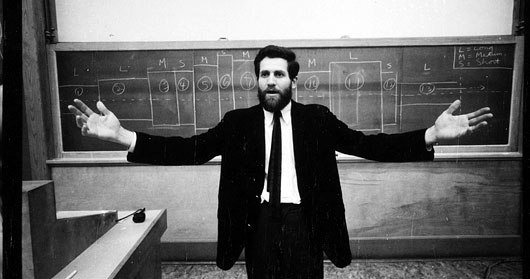
Allan Kaprow NK: Yeah. He was really important to me. He wasn't my advisor but I was really fond of him and we would talk a lot about art together and worked together a bit too. Well, listen, I'm going to go. If you want to talk more later I'm happy to, just text or call if you want to continue this, but I've got to get on the plane. GW: Thank you so much for making the time. I really appreciate it. NK: No problem. Please send it to me when its done too. GW: I will, definitely. NK: Take care. GW: Bye. Katchadourian's Sorted Books is on view at PNCA's Feldman Gallery until October 23, 2010. Posted by Gary Wiseman on September 17, 2010 at 14:52 | Comments (0) Comments Post a comment Thanks for signing in, . Now you can comment. (sign out)
(If you haven't left a comment here before, you may need to be approved by
the site owner before your comment will appear. Until then, it won't appear
on the entry. Thanks for waiting.)
|
| s p o n s o r s |
 |
 |
 |
 |
 |
 |
 |
 |
 |
 |
 |
 |
 |
 |
 |
 |

|
Site Design: Jennifer Armbrust | • | Site Development: Philippe Blanc & Katherine Bovee | |

